The Taj Mahal is situated in Agra on the banks of the river Yamuna. It is in the state of Uttar Pradesh in the northern part of India, very close to New Delhi, the capital of India. The Taj Mahal is the epitome of beauty and an architectural feat. It stands smugly in all its glory even after many centuries since its construction.
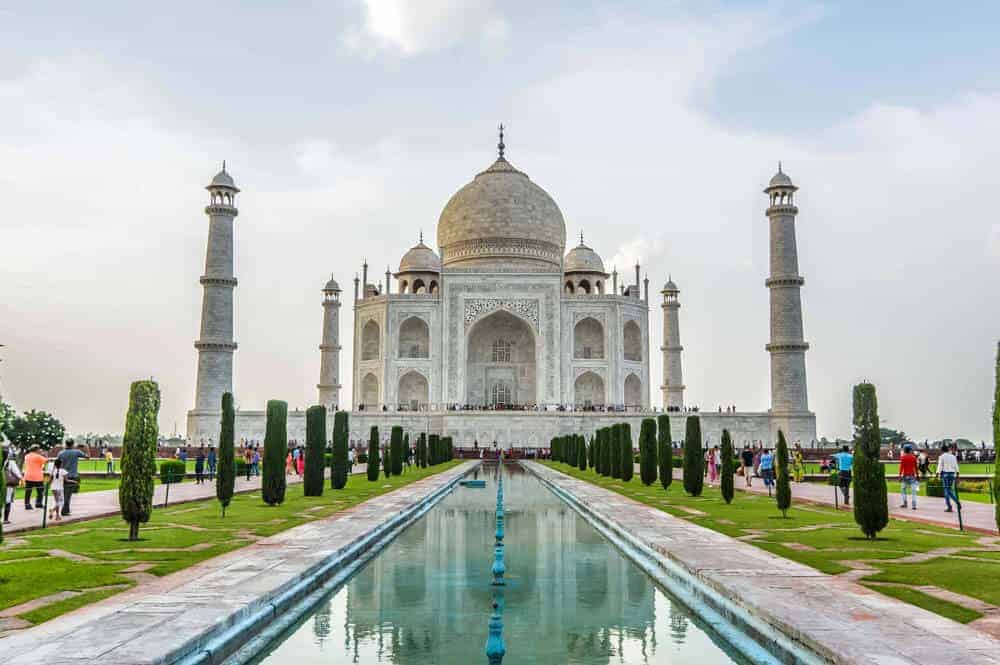
Shah Jahan commissioned the construction of the Taj Mahal as a symbolic expression of love to his dear wife Mumtaz Mahal upon her death in the year 1631. Taj Mahal not only evokes a sense of amazement at the extent an Emperor could go to build a monument of this sheer size for his love but also marvel at the precision and symmetry achieved in building this.
Such is the beauty of this monument that it is considered one of the Seven Wonders of the World and rightly a UNESCO World Heritage Site. The Taj Mahal receives anywhere between 7 – 8 million visitors annually. It is one of the most favorite destinations in the world for domestic and foreign tourists alike.
The below guide will give you all the details that you need before packing your bags to visit this enchanting place. We will talk about how you can reach the place, the best time to visit, the reason why the Taj Mahal was built, facts, photography tips and any watch outs to be aware of for a safe and fun trip. All the information provided in the guide is valid as of June 2018.
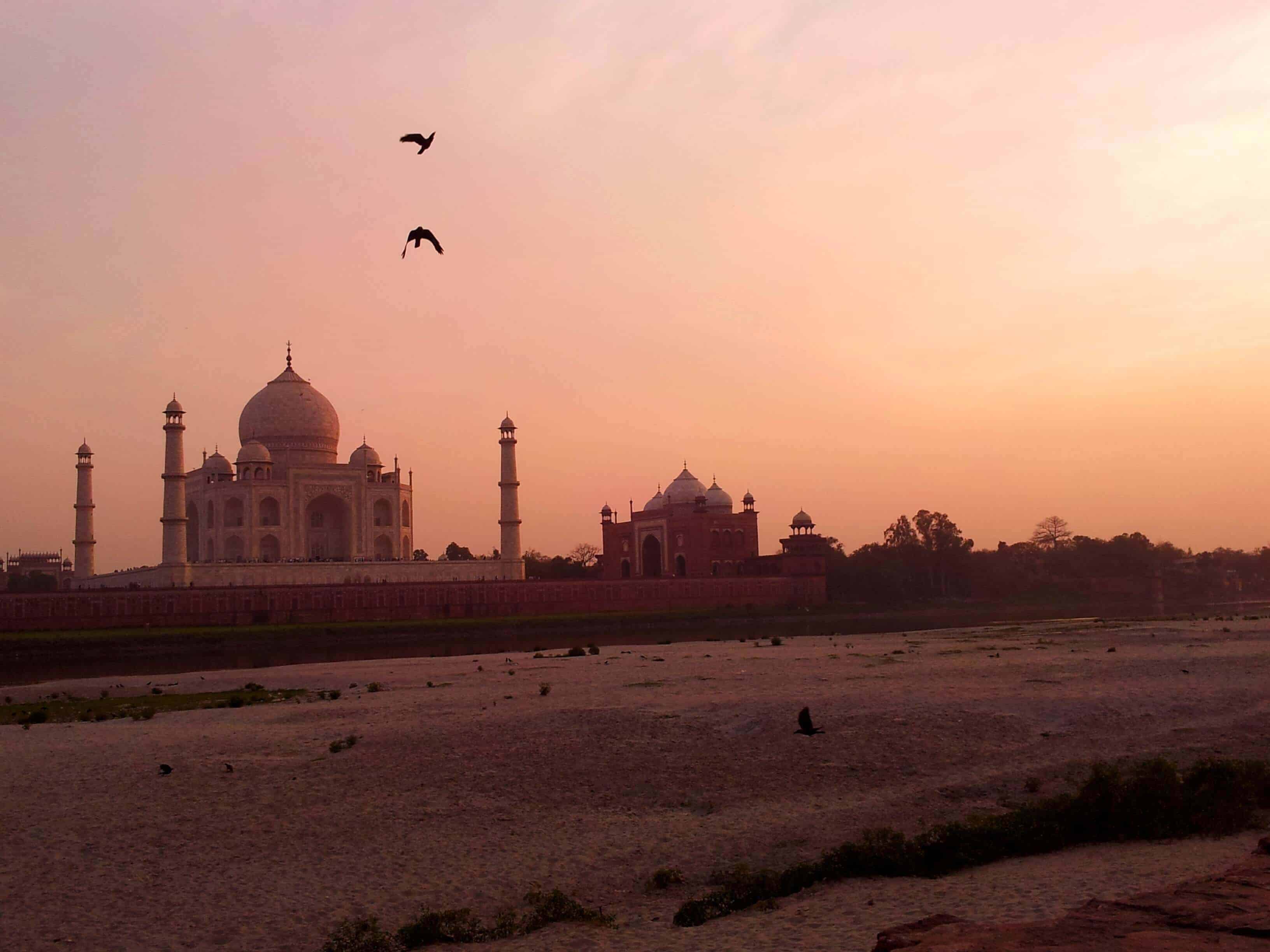
Taj Mahal is approximately 222 km away from New Delhi, so you will need around 3 – 4 hours by road or by train. Though the Taj Mahal makes for a good one-day trip, it is good to stay overnight as viewing the Taj during sunrise is an experience in itself.
1. Best time of the year to visit the Taj Mahal
Here is a chart showing the average temperature for each month of the year at Agra
| Month | High / Low (°C) | High / Low (°F) |
| January | 21° / 7° | 69.8° / 44.6° |
| February | 25° / 10° | 77° / 50° |
| March | 32° / 15° | 89.6° / 59° |
| April | 38° / 21° | 100.4° / 69.8° |
| May | 41° / 25° | 105.8° / 77° |
| June | 40° / 28° | 104° / 82.4° |
| July | 34° / 26° | 93.2° / 78.8° |
| August | 34° / 26° | 93.2° / 78.8° |
| September | 34° / 24° | 93.2° / 75.2° |
| October | 34° / 19° | 93.2° / 66.2° |
| November | 29° / 12° | 84.22° / 53.6° |
| December | 24° / 8° | 75.2° / 46.4° |
The Taj Mahal is open on all days except Fridays so plan your travel dates accordingly. The best time to visit Agra is during the winter between October to March. Though the air is bitter cold in the night, the warmth of the sun during the day makes for a perfect visit in these months.
You can visit the Taj Mahal during the summer too from April to June. Beware that the temperatures during the day are very high and if you are sensitive to heat, you can visit the Taj during sunrise or sunset when the temperature is bearable. The advantage of visiting the Taj during summer is that there are fewer people compared to the peak season and hence a better time spent at the venue.
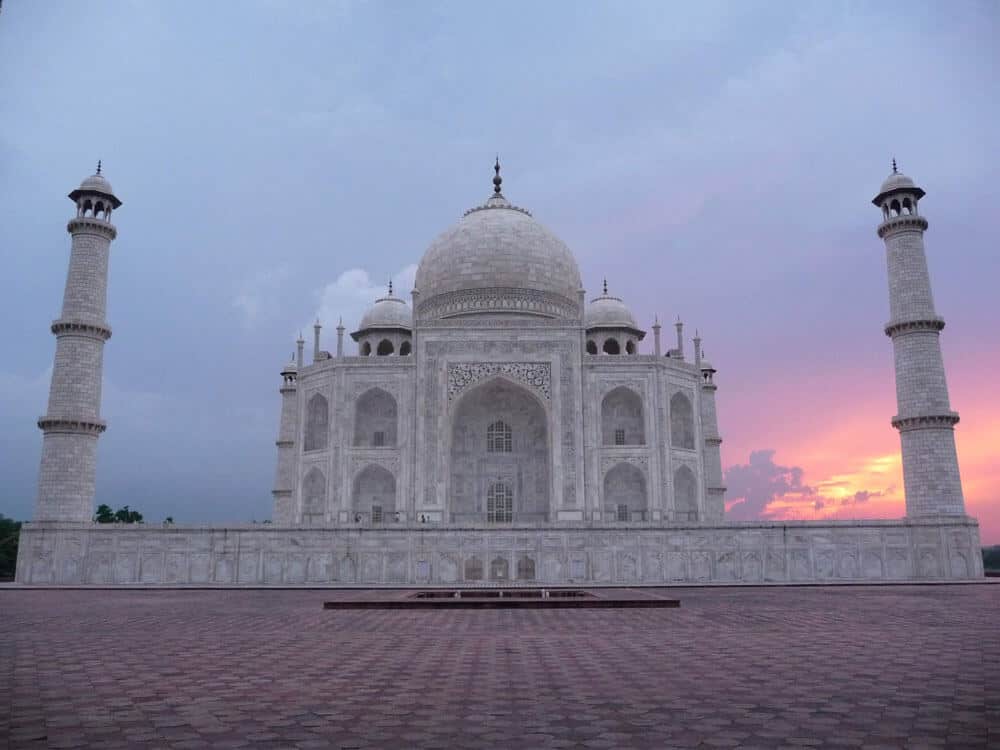
2. Best time of the day to visit the Taj Mahal
The best time of the day to visit the Taj Mahal is undoubtedly, during sunrise. The authorities open the gates to travelers at 6 am every day. This is the perfect time for two reasons: lesser crowds and the elegant golden shine of the Taj against the first rays of the sun. You can hang around as long as you want inside the premises of the Taj Mahal, so make the most of this time to click great shots of this grand mausoleum. The crowd is thinner and hence a better experience. As the day passes, the crowd increases and finding a good photo op is a bit challenging.
The Taj Mahal as it is widely said does reflect different shades of color depending on the time of the day. If you are willing to enter multiple times for photographing the Taj at various times of the day, then visit during sunrise, middle of the day or during sunset. If you are skeptical about visiting twice, then you can enter the complex and stay for as long as you want for one ticket. So, as a tip, you can enter at 6 am and leave at around 10 or 11 am. Or enter the complex at 3 pm and witness the sunset and head back. You must note that there is absolutely no access to food, so be prepared in advance.
If you are flexible with dates, plan your visit around the full moon night when the Taj is open to visitors in the night between 8.30 pm to 12.30 am. Night viewing of Taj Mahal is available on five days in a month i.e. on full moon night and two nights before and two after the full moon. Each visitor is given just 30 minutes to behold the glory of the Taj as it glistens under the moonlight. However, the Taj is closed on all Fridays during the month of Ramzan.Though there is some extra effort involved in visiting the Taj at night, it is definitely all going to be worth it. There is no other monument in the world which has special viewing allowed exclusively around the full moon day.
Few things to bear in mind before you plan the night visit are:
– You need to buy the ticket in person at Archaeological Survey of India (A.S.I) 22, Mall Road, Agra 24-hours before the planned entry
– If you want to cancel the ticket, then you will be refunded 75% of the amount
– Visitors are allowed in 8 batches of maximum 50 people each and are allowed strictly for 30 minutes only
– For a quick glance as to when is the upcoming full moon days this year and the coming years, have a look at this list here
3. Ticket prices to visit the Taj Mahal
Tickets to enter the Taj Mahal are sold at two entry points – the Western and Eastern Gates. There are different ticket price slabs based on the nationality of the traveler. If you are a foreigner visiting the Taj Mahal, then the tickets are slightly priced higher at INR 1000.
| Visitor Type | Price in INR (approx. $ value) |
| Adult (Indian) | 40 INR (< $ 1) |
| Adult (Foreigner) | 1000 INR ($ 15) |
| Adult (Citizens of SAARC and BIMSTEC Countries) | 530 INR ($ 8) |
| Children below the age of 15 (domestic and foreign) | Free |
Note: SAARC countries are Afghanistan, Bangladesh, Bhutan, India, Nepal, the Maldives, Pakistan andSri Lanka. BIMSTEC member nations are Bangladesh, India, Myanmar, Sri Lanka, Thailand, Bhutan, and Nepal
Ticket prices for night viewing of the Taj Mahal
| Visitor Type | Price in INR (approx. $ value) |
| Adult (Indian) | 510 INR ($ 8) |
| Adult (Foreigner) | 750 INR ($ 12) |
| Children between 3 – 15 years (all nationalities) | 500 INR ($ 8) |
It is recommended to buy the tickets online here before reaching the venue. With an e-ticket, you can avoid the hassle of standing in long queues to buy the ticket. The Taj Mahal invites a lot of domestic tourists during summer vacation and you wouldn’t want to stand in the sweltering heat, wasting time to buy tickets.
Though the process of buying tickets is easy, you cannot evade the mandatory security check. The length of the queue for the security check early mornings at 6 am are shorter and the process is swifter. As the day proceeds, the length of the queue gets longer. Be patient and keep your tickets handy to show it to the police to gain entry.
Do not forget to carry necessary government approved ID cards with you when you visit the Taj Mahal. If you are a foreigner, do carry your passport with you at all times.
There are a lot of places to exchange currency in Agra since it is a top tourist destination in India. You can find a lot of them on the popular Fatehabad Road in Agra. You can exchange currency at reliable places listed here.
4. How to reach Agra
Agra is well connected by air, rail, and road.
| Mode of Transport (to & fro from New Delhi) | Price in INR (approx. $ value) | Approximate Duration |
| Air | 4000 – 7000 INR ($ 60 – 100) | 1 hour one way |
| Bus(Public Transport) | 1000 – 3000 INR ($ 15 – 45) | 4 hours one way |
| Rail | 1500 INR ($ 20) | 1.5 hours one way |
| Car | 5000 INR ($ 75) | 4 hours one way |
| Rickshaw (within the city) | Max 50 INR per person per ride |
By Air
Taking a flight to Agra is the easiest from New Delhi as this is the only city that has direct flights to Agra. Rest of the cities in India including the metros like Mumbai, Kolkata, Chennai, Hyderabad, and Bangalore do not have direct flights to Agra.
Pre-book your tickets to fly between New Delhi and Agra. Domestic airlines provide daily connectivity and the average cost of the ticket to and fro ranges between 4,000 INR to 7,000 INR depending on the season.
By public transport
There are state-run and private-run buses plying between New Delhi and Agra on a daily basis. This is comfortable and cheaper to ride as the fare costs a maximum of 1000 INR to and fro.
Pre-booking of bus tickets might not be necessary as there are a number of buses which ply frequently but why take the risk, have a ticket handy in advance. You can book your bus ticket on the popular Red Bus website.
By rail
If you would like to have a peek at the changing landscape from the cosmopolitan New Delhi slowly transforming to a town passing through fields, take a train. There is the 12050 Gatimaan Express (non-stop), 12002 New Delhi Bhopal Shatabdi Express and the 12280 Taj Express Superfast departing from New Delhi’s Hazrat Nizamuddin Railway Station every day between 6.00 am to 8.30 am. The journey is just two hours long with catering services on board. The main railway station in Agra is Agra Cantonment (AGC). You can book your tickets on the Indian Railways website.
Try taking the train journey during daylight. Avoid traveling by train in the night to and fro from New Delhi for security reasons, especially if you are a solo female traveler.
By hired car
If you want to hire a car to travel to Agra, then there are many available vendors in New Delhi. The cost of to and fro journey would cost up to of 5000 INR. There is the Taj Express Highway exclusively built to ease travel by road to this heritage site. As the name suggests, this is a six-lane express highway, India’s longest expressway connecting Greater Noida which is outside New Delhi to Agra. You can book a cab here on Savaari Car Rentals or take Ola outstation trips or even an Uber.
Upon reaching Agra through air, bus or train, use the 24-hour official prepaid auto rickshaw and taxi booths just outside the airport, bus stand, and railway station to reach your hotel.
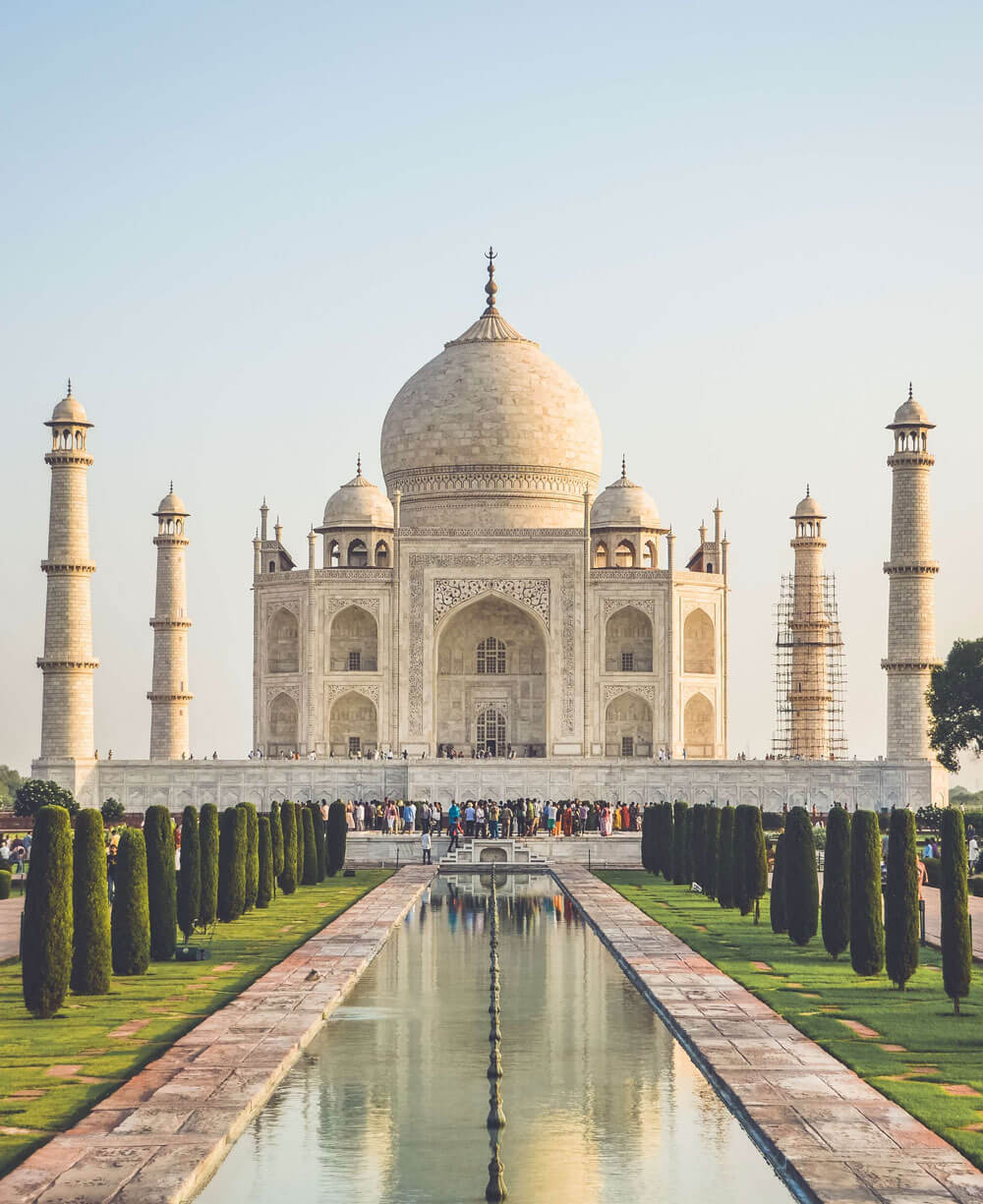
Reaching the Taj Mahal
You can reach the Taj Mahal by hiring a cab or a rickshaw from your hotel. All petrol and diesel vehicles are prohibited near the monument to curb pollution and further damage from the soot from these vehicles to the sparkling white marble of the Taj. There is a designated spot where you will be dropped from where you can walk 600 meters to the entrance or there are frequently plying electric vehicles. You can hitch a ride with them for INR 20 per head. Or you can take a cycle rickshaw for INR 50.
5. Where to stay near the Taj Mahal?
There are multiple hotels in Agra and near the Taj Mahal where you can stay overnight. Here are a few suggestions for accommodations for a range of budgets.
For luxury travelers, there is the Oberoi Amarvilas, a 5-star hotel. It is just 600 meters away from the monument of love and every room has fantastic views of the Taj Mahal. You can relax, dine and rejuvenate in the spa with luxury meant for the royals at prices starting from 32,000 INR (approx. $470) per night.
Other semi-luxury hotels are Jaypee Palace Hotel, Courtyard by Marriott Agra, Trident Agra, and ITC Mughal, Radisson, Hotel Ramada to name a few. The price per night ranging between 6,000 – 10,000 INR ($ 90 – $ 150).
If you are a backpacker with a minimal budget, you can stay in hostels like Rhine Hostel, Spiritual Yoga and The Coral Court Homestay for as little as 1000 INR ($ 15) or less than that.
These accommodations have great customer reviews and hence reliable. Book your stay in advance for a hassle-free travel experience. (We do not promote hotels or accommodations for any kind of business gains)
6. Considerations for women and kids
Like any other monument across the world, eating and smoking are strictly prohibited in the premises of the Taj Mahal. If you are traveling with kids, have them fed well in advance as the trip inside the Taj Mahal will surely take a good 3-4 hours of your time as you will be marveling at its beauty to no end. As suggested above, if you are staying longer, from sunrise to the middle of the day or from mid-day until sunset then eat well in advance. There are free water dispensing units inside the Taj Mahal, but carrying your own bottle is better to avoid the long queue waiting to drink water.
Though there are no restrictions on the dress, it is wise to be dressed moderately. Try to cover your shoulder and legs to be respectful to local culture. If you want to enter the mosque inside the monument, being well dressed helps in entering without any hassle.
If you are visiting in summer, do not forget to carry a hat and cover your arms will full sleeves clothing as the sun gets very harsh. Carry a sunscreen at any cost. There are benches at regular intervals for you to sit and rest. If it is crowded, then you will have to wait for your turn.
Read our other guide to get tips to travel as a female in India.
7. Is the Taj Mahal disable friendly?
Yes, the Taj Mahal is disabled-friendly with wooden ramps provided near the entrance, the security checkpoint and when you pass through the Southern Gate.
Since the whole monument is vast, it is better to have an electric wheelchair to steer within the complex. There is an electric vehicle which ferries visitors from the parking lot to the Taj Mahal as all private vehicles are banned near the Taj Mahal. This electric vehicle does not have a built-in ramp for visitors on a wheelchair to board. You might need help in boarding the electric vehicle and carry your wheelchair separately with you. If you are on an electric wheelchair, you can go the entire distance on your own since the Taj Mahal is just 600m away from the parking lot. This 600m distance is flat and paved well, so reaching the monument should not be a problem. This is possible only if the weather is pleasant during sunrise or sunset. Please do not try this midday when the sun is high above the head.
The only regrettable side to visiting the Taj Mahal is that there is no ramp built to access the main mausoleum for wheelchair-bound visitors. The tomb is on a 7m high plinth and unfortunately, there is no provision to lift passengers from the ground level to the tomb. You can read more about a fellow traveler’s experience on the wheelchair when she visited the Taj Mahal here. You can also read reviews and suggestions from locals on TripAdvisor if you need help with the wheelchair when you visit the Taj Mahal.
8. The story behind the construction of the Taj Mahal

Coming to the history of the Taj Mahal, it was the Mughal Emperor Shah Jahan who commissioned the construction of this exquisite monument as an expression of his love to his dear wife Mumtaz Mahal. Shah Jahan was the son of the Mughal Emperor Jehangir and grandson of Akbar, the Great.
Mumtaz Mahal, meaning the ‘Beloved Ornament of the Palace’ or ‘Chosen One of the Palace’, was called so by Shah Jahan, while her actual name was Arjumand Banu Begum.Though Mumtaz Mahal was Shah Jahan’s third wife, poets of that era would extol her beauty, gracefulness, and compassion. She was his trusted companion and traveled with him all over the Mughal Empire. It is said that the official court chronicler Qazwini, said that Shah Jahan’s other wives Akbarabadi Mahal and Kandahari Mahal were nothing but a mere showcase of status but his love resided with this third wife to whom the Taj Mahal was dedicated.
At the time of her death, Mumtaz had been accompanying her husband while he was fighting a campaign in the Deccan Plateau.In the year 1631, Mumtaz Mahal, unfortunately, breathed her last while giving birth to their 14thchild. The demise happened in Burhanpur which is in present-day Madhya Pradesh. Her body was temporarily buried at Burhanpur in a walled pleasure garden known as Zainabad on the banks of the Tapti River. Shah Jahan was so devastated with his loss, that he was inconsolable and was in deep grief at her demise.Shah Jahan returned to Burhanpur to conclude the military campaign and in the same year in 1631, he decided to move the remains of his dead wife.
The remains of Mumtaz Mahal was transported in a golden casket escorted by her son Shah Shuja and the head lady in waiting of the deceased Empress back to Agra. There it was interred in a small building on the banks of the river Yamuna.It is when Shah Jahan was in Burhanpur, that he decided to build the Taj Mahal, the ultimate monument of love and homage to his dear wife.
9. Construction of the Taj Mahal
The construction began in 1631. Masons, stonecutters, inlayers, carvers, painters, calligraphers, dome-builders and other artisans were requisitioned from the whole of the empire and also from Central Asia and Iran, and it took approximately 22 years to build.An epitome of love, it made use of the services of 22,000 laborers and 1,000 elephants. After an expenditure of approximately 32 million rupees, Taj Mahal was finally completed in the year 1653.
The Taj Mahal and the entire complex that is constructed around it is a classic example of the Mughal style of architecture with the Islamic tomb as a prominent feature. There is a combination of Persian, Islamic and Indian architectural style in the construction.

White Makrana marbles were sourced from Rajasthan and the surrounding three complexes were built with red sandstone sourced from Fatehpur Sikri.
As if the construction in itself wasn’t magnificent enough with symmetry achieved in every detail of the whole complex, the most astonishing is the intricate design achieved using rare and semi-precious stones. These stones were sourced from far-flung areas which speaks volumes of the commitment that Shah Jahan had to build the most beautiful monument ever which stands the test of time.
Apparently, Shah Jahan himself was very knowledgeable about the stones that were being used in the construction of the Taj Mahal. He was personally involved in the design of this monument and it is this mastery that is evident in the architecture of the Taj. This scale of construction also signifies the power and strength the Mughal Empire enjoyed those days. Shah Jahan under his rule was able to build a monument of this scale without any disturbances in the power circle or face any financial hurdles during its construction.
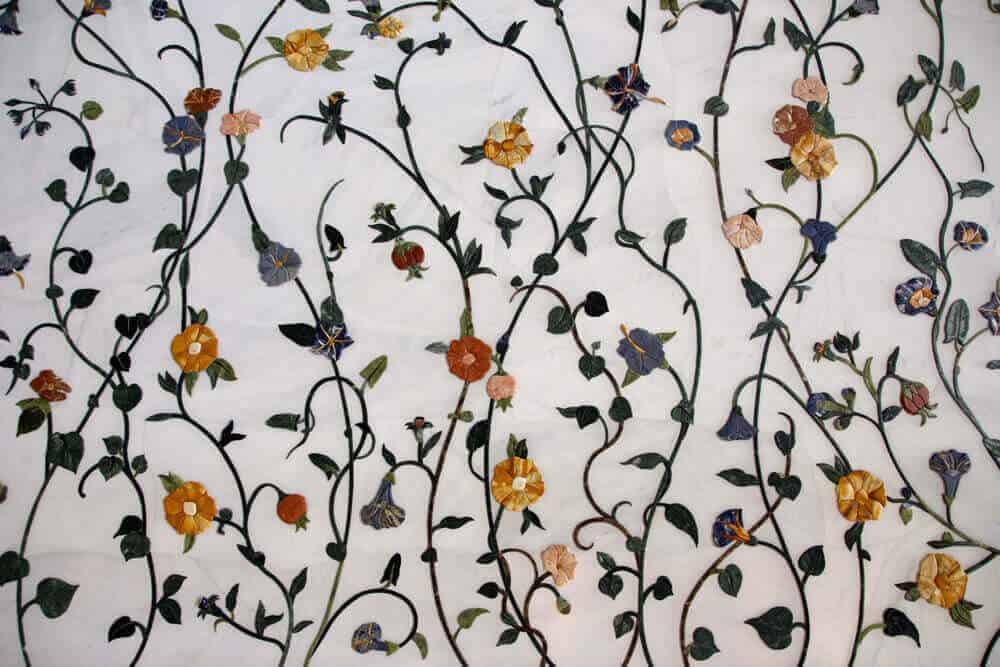
A lot of rare and semi-precious stones were used in the floral motifs that adorn the walls of the Taj Mahal. More information about the stones, marbles, and sandstone used can be read in detail here. These stones were carefully embedded into the marble using the traditional Pietra Dura style of mosaic work. This decorative art form using semi-precious stones is also called Parchin Kari in the Indian subcontinent. This traditional art form is passed down from generations and there are artisans in Agra who continue to make this rock art at a smaller scale for souvenirs. A travel blogger took this special trip and has beautifully explained this delicate technique here accompanied by brilliant pictures.
10. Architecture of the Taj Mahal
A labor force of about twenty thousand workers was recruited from across Northern India. Sculptors from Bukhara, calligraphers from Syria and Persia, inlayers from southern India, stonecutters from Baluchistan, a specialist in building turrets, another who carved only marble flowers were part of the thirty-seven men who formed the creative unit. The detailed history can be read here. The Taj Mahal covers an area of 42 acres in total. Everything about the Taj Mahal, the two complexes flanking its sides, the garden, and the gateway are symmetrical. There was absolutely no room for error and the attention for detail in this aspect is worth an applause. The architect to plan, supervise and build the Taj Mahal was Ustad Ahmad Lahauri.
10a. The Southern Gate or the main gateway
The main gateway is the first to catch your glimpse when you finish the security check at the entrance. This is referred to as Darwaza-i-Rauza or ‘gate of the mausoleum’ which is one of the main elements of this monument. This is considered as the South Gate which in fact is the main entrance to the Taj Mahal.
The gateway is made of bricks covered with red sandstone. There is Arabic calligraphy bordering the doorway which is nothing but quotes from the Quran calling the visitor to enter the Paradise Gardens. The quote is etched in black stone into white marble. You can notice eleven little domes just above the entrance on the gateway. There is another set of eleven little domes on the other side of the gateway, totaling 22 little white domes, signifying the precise number of years it took to construct the Taj Mahal.
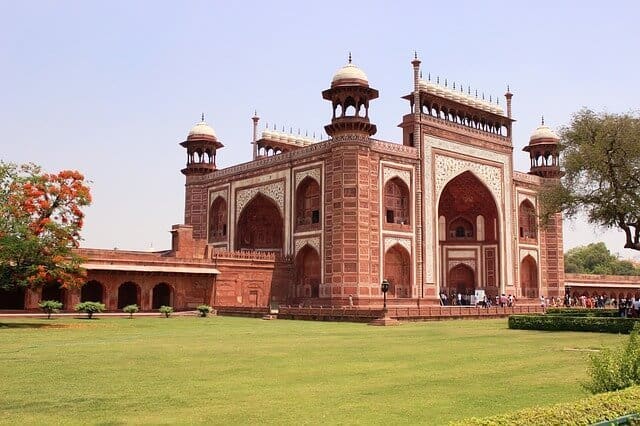
As you walk past from the security check towards this Darwaza, you can catch a glimpse of the Taj Mahal but it gets completely out of view when you stand in front of this splendid gateway. As you enter the gateway and stand inside the entrance, that you can see the Taj Mahal in its full glory.
As you walk past the Darwaza, you are welcomed to the view you have been preparing for all this while. The white mausoleum perched on a plinth sparkling white at the end of the long watercourse and interspersed garden.
10b. Char Bagh or the Garden
The garden is called Char Bagh and is a perfect 300 square meters in dimension. Even the garden, when viewed from above is divided into 4 pieces by 4 calm water bodies. These 4 waterways represent the sea of water, wine, milk and honey which signify paradise as mentioned in the Quran. Each of the 4 sectors is further equally divided into 4 quadrants, making it a total of 16 pieces of the garden with lawn.
The Char Bagh is referred to as the Paradise in this context as the presence of water and so much flora along with chirpy birds and little animals represented great happiness.Recorded documents have mentioned that the Char Bagh garden was full of fruit-bearing trees, fragrant flowering plants thriving with life. As time went by, the ruling British used to enjoy picnicking in these grounds and the Guest House on the eastern side used as a guest house literally.
It was when the British Viceroy to India, Lord Curzon witnessed the sad state of affairs at the Taj Mahal did he begin restoring this monument. He was known to care for Indian heritage and its architecture and he personally oversaw the restoration and maintenance of many monuments but he had a special connection with the Taj Mahal. He was so passionate about the Taj Mahal that he spent money from his own pocket and from the government towards the upkeep of this monument. He ordered the trees to be removed and made for flat gardens and introduced lawns here for the first time. He thought the grass accentuated the vista of the Taj Mahal and the waterways easily.
The other important elements of the Taj monument are the Mosque and the Guest House. Both these complexes are built using bricks covered with red sandstone. They are a replica of each other and hence symmetrical in design and in architecture, also adding an aesthetic color contrast.
10c. Mosque on the Western Side
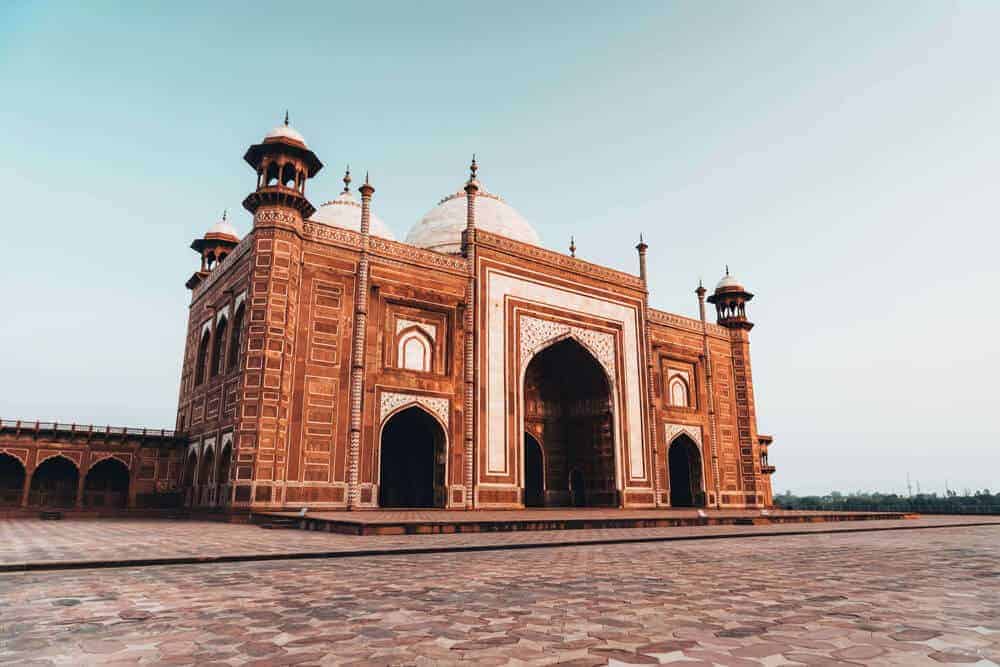
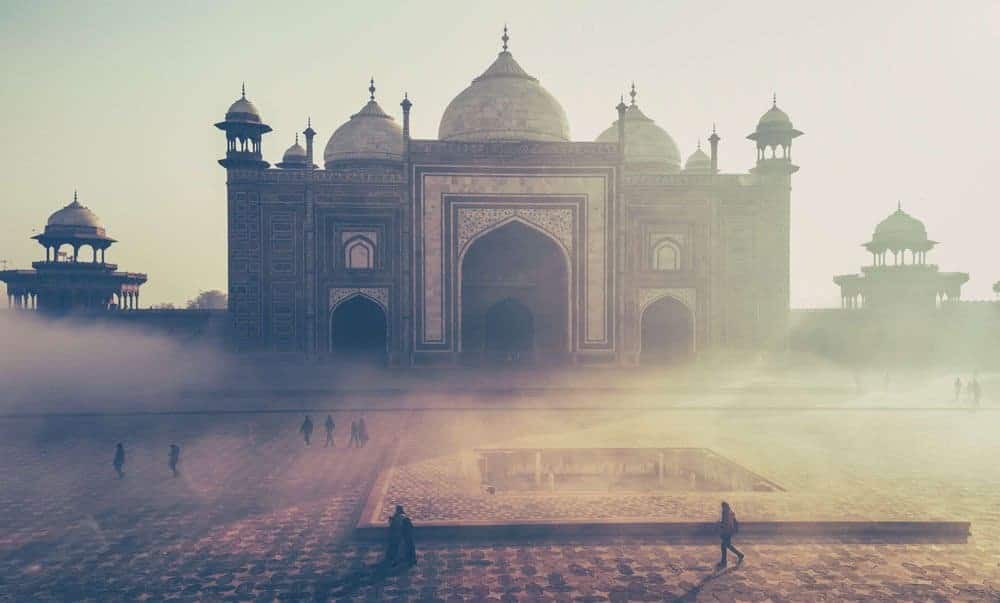
The mosque is on the left or the western side of the complex. Used for prayer purpose, the mosque faces the direction of the holy city of Mecca. Additionally, there lies a small stone enclosed space of 19 ft by 6.5 ft, which had served as a temporary grave where the remains of Mumtaz Mahal were kept for some time when they were first brought to Agra, until they finally found an eternal place of rest inside the beautiful mausoleum built in her precious memory.
10d. The Guest House on the Eastern Side
The guest house is also called as the Naqqar Khana, Mihman Khana, or the Assembly Hall. It is located on the eastern side of the Taj. It is believed that the rest house was built to provide a ‘jawab’, which translates to ‘answer’, as it balances the architectural symmetry and harmony of the whole structure. The exact purpose of the guest house is still not clear though it could have been used to house pilgrims who came here on caravans.
10e. The main mausoleum
Now coming to the main aspect of this blog and the whole travel itself which is the Taj Mahal meaning ‘Crown of all Palaces’ in Persian. It stands tall at 73m, raising 7m from the gardens on a plinth. Each minaret is 43m high to emphasize the beauty of the spherical dome. The dome is the most spectacular feature of the monument, being 17.7m in diameter for a height of the arc of 24.4m. The shape of the dome is emphasized by four smaller domed chattris(umbrellas) placed at its corners.
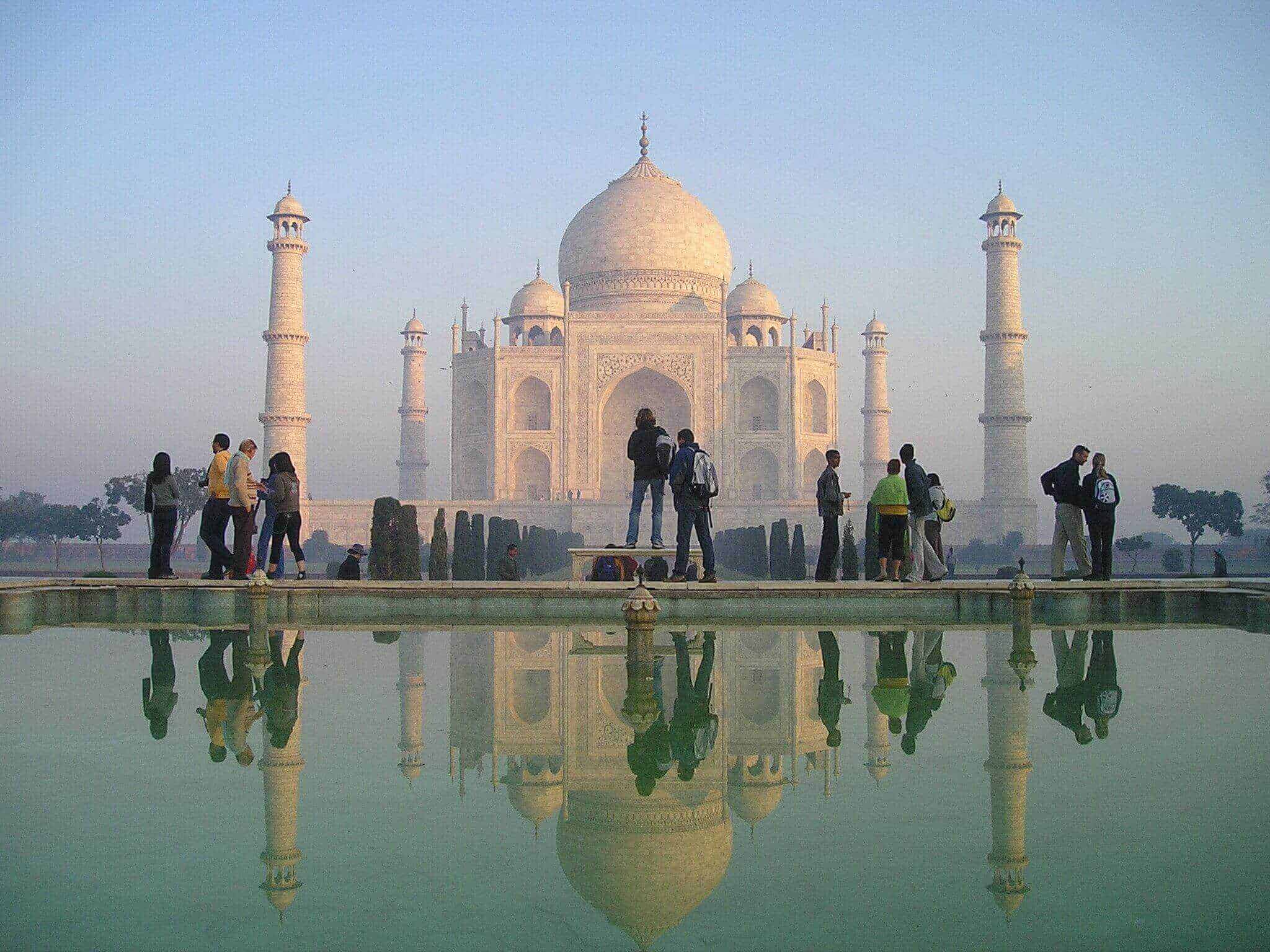
The four minarets at each corner of the Taj Mahal are not built at an exact 90° to the level of the ground, rather built a few degrees slightly outwards from the main dome. This is to avoid any structural damage to the main mausoleum if the minarets crashed in case of an earthquake or any such disaster.
The dome is topped by a brass finial, which mixes traditional Persian and Hindu decorative elements. The finial is topped by a moon, a typical Islamic motif, whose horns point towards heaven. Because of its placement on the main spire, the horns of the moon and the finial point combine to create the shape of a trident —reminiscent of the traditional Hindu symbols of Shiva. The exact design of the finial is drawn on the ground between the Taj Mahal and the Guest House.
10f. The interiors of the mausoleum
The interiors of the Taj Mahal have the cenotaphs of Shah Jahan and Mumtaz Mahal. The actual burial chambers of Shah Jahan and Mumtaz Mahal are under the ground just below the cenotaphs which are not in view. Visitors are not allowed to access this place.
The cenotaph of Mumtaz Mahal is exactly in the center of the hall abiding by the rules of symmetry this monument strictly follows.When Shah Jahan died in 1666, his body was placed in a tomb next to that of Mumtaz Mahal. The larger cenotaph of Shah Jahan was added on the western side. This clearly threw the symmetry of the entire monument off balance. This indicates that Shah Jahan’s grave and cenotaph were never meant to be here at all but placed here on the orders of his son Aurangazeb upon his father’s death.
The most exquisite of any wall art that you can ever find is on display in the interiors and exteriors of the Taj Mahal. There is the very delicate marble screen or jali inlay which surrounds both the cenotaphs. This intricate design on the rock is equivalent to a fine piece of jewelry. The marble is perforated with precious stones to have an ornamental look interlaid with flowers and leaf designs. It looks so fine that when you touch it, it feels like a painting and it is difficult to believe that they are exotic stones interlaid into marble.
There is a beautiful bronze lamp hanging from the roof on the inside of the dome above the cenotaphs. This bronze lamp inlaid with gold and silver was a special gift from Lord Curzon to the monument. It has Persian words engraved on it, which reads as ‘Presented to the Tomb of Mumtaz Mahal by Lord Curzon, Viceroy 1906’.History has it that when Lord Curzon used to visit the Taj Mahal he was shocked and appalled to see dim and poorly lit lamps used inside the mausoleum, so he took it upon himself to find the best lamp to match this lavish beauty. In one of his journeys from India to London through Cairo, he met scholars and artisans to have a replica of the lamp that once hung from the mosque of Sultan Baibars I in Egypt. An experienced artisan by the name of Todros Badir was chosen by him to execute the job who took almost two years to finish this masterpiece. This bronze lamp now majestically hangs inside the mausoleum.
10g. The exteriors of the mausoleum
The mausoleum has four sides with chamfered corners. Each of these corners has pilasters with designs which make for good optical illusion. These pilasters have 4 sides, with the forth side attached to the wall. The remaining 3 sides are equal in length with V-shaped motif stacked on the entire pilaster.
Try this trick when you are there – stand at least 3 meters away from the wall, fix your eyes at the V-shaped motif and walk closer. As you walk closer, look up slowly and your eyes are tricked to see six sides of the pilaster and not three.
There are Quranic verses on the mausoleum, with Jasper inlaid into marble and has thuluth script. The texts refer to themes of judgment: of doom for nonbelievers, and the promise of Paradise for the faithful.Since there is a prohibition in Islam to depict any human or animal forms in religious art and architecture, you will find a lot of floral motifs in the design of this monument. You can see flowers, leaves, and wines carved out of plain marble in the interiors.
The Taj Mahal was built in stages, with the plinth and the tomb taking up roughly 15 years. The building of minarets, mosque, jawab, and gateway took additional 5 years to be completed.
Check out this quick visual guide of the Taj Mahal from Patrick Schwerdtfeger when he visited the monument with a professional travel guide. He shows all the main aspects of the Taj Mahal in his visual tour accompanied by a brief description.
11. Photographing tips
The Taj Mahal is a photographer’s dream as this exquisite monument radiates with its charm. Here are a few tips to bear in mind to get great shots of the Taj.
Professional video making inside the complex is strictly prohibited. You need to take prior permission from the office of Archaeological Survey of India located at 22, Mall Road, Agra. If you are capturing a video for a blog, it should be fine.
As soon as you enter the main gateway referred to as the Darwaza-i-Rauza, this is the first time you will get to see the Taj Mahal. The Taj Mahal stands magnificently tall and the mausoleum is designed in such a fashion that you do not get a glimpse of this huge structure until you stand inside the Darwaza-i-Rauza. The appearance of the main tomb of Taj Mahal from the interiors of the Darwaza-i-Rauza is your first tryst with the Taj. This is a great spot to click some fantastic pictures.
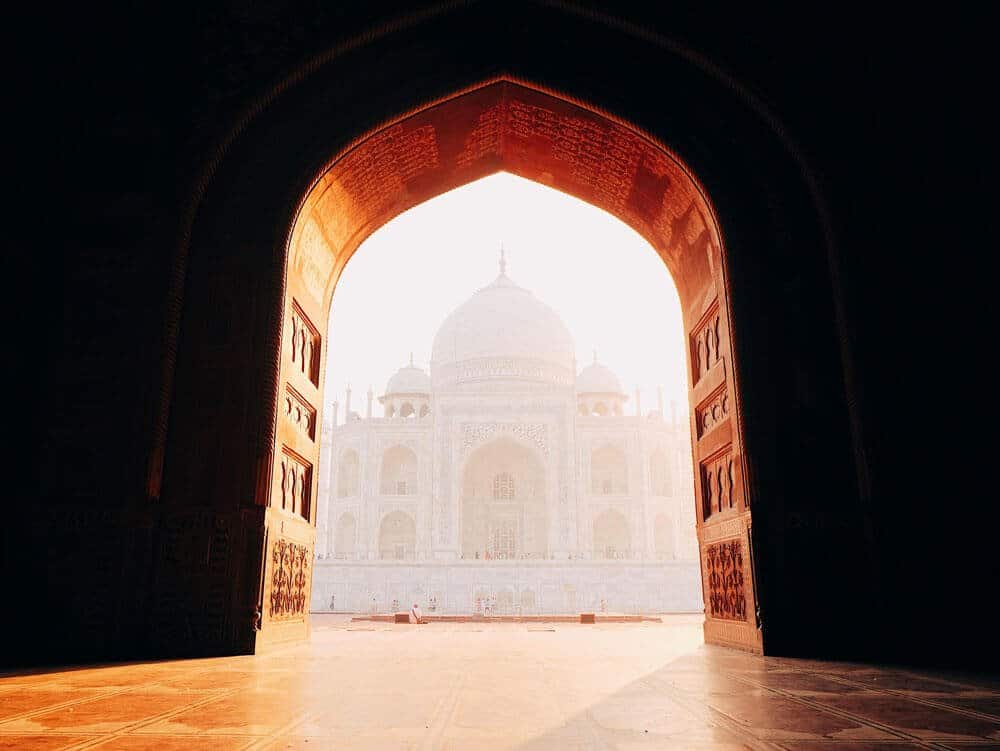
As you walk past the main gateway, you will witness the Taj Mahal in its entirety. Standing in front of the Taj, just outside the main gateway, this is one of the best views of the Taj Mahal along with the four minarets. The ivory white marble fades into the blue sky at the end of the green garden and the waterway right opposite to the Taj Mahal adds a beautiful dimension to the viewer.
Another nice spot for you to pose for a pic with the Taj in the background is on the elevation in front of the Taj Mahal popularly known as the ‘Diana Bench’. The name has caught on since Princess Diana’s visit to the Taj Mahal where she sat and posed for the famous picture. You will need to wait a few minutes here for your turn to get to sit on this special bench and pose. This gives you a closer view of the Taj Mahal.
Walk towards your right for the Taj Mahal Rest House, also referred to as Guest House. This structure is on the eastern side and hence with the sunrise behind you, the Taj Mahal from this viewpoint looks golden in color and you can appreciate the symmetry and the design perfectly replicated on all four sides of the Taj.
Another interesting viewpoint of the main mausoleum is from the mosque on the western side. With the sun slowly looming over the Taj Mahal, the silhouette of the dome and the finial on top of the dome looks very prominent when you watch from the inside of the mosque. Some of the best shots of the Taj Mahal are captured from this spot. You can observe a lot of pigeons fluttering around which will add a tinge of life to this towering structure. Many award-winning shots of the Taj Mahal is captured from this point.
With the river Yamuna flowing beside the Taj Mahal, request your guide to take you to the other side of the Taj Mahal which has the Mehtab Bagh garden. This is an excellent place to behold the symmetry of not just the main mausoleum but the whole complex in itself. The Taj Mahal including the rest house on its left and the mosque on its right combined with the reflection on the water of the river is a brilliant photo op. If you haven’t hired a guide, you can hire a rickshaw to go to Mehtab Bagh for a price of around 100 INR.
Last but not the least, the beauty of the Taj Mahal is exceptional during and around the full moon night. Within the 30 minutes of time provided in the night, capture the glory when the Taj glimmers under the radiant moonlight.
When you visit the Agra Fort, you can see the Taj Mahal at a distance. You see the main dome, the four chattris(umbrellas) around the dome and the four minarets beside the Yamuna river which makes for a good photo op.
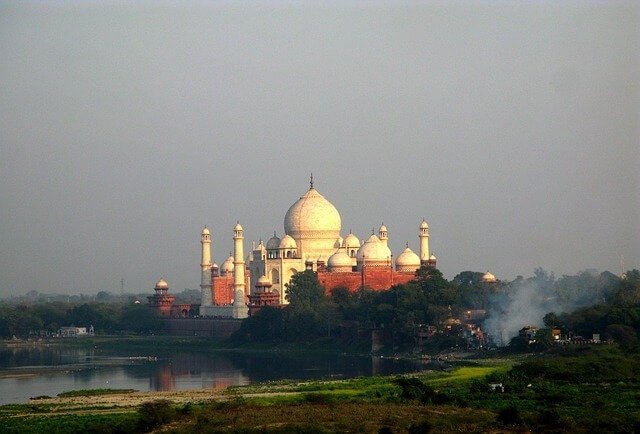
12. Myths of the Taj Mahal
As if the story behind the construction of this monument wasn’t fascinating enough, there are a lot of unverified stories and myths about the Taj Mahal. We have listed out a few of them for you. If you want to read the origin of the myth and how they were debunked, read them in detail here.
12a. Black Taj
With so much importance being given to the concept of symmetry in the construction of the Taj Mahal, there are unverified stories of how Shah Jahan wanted to construct a monument similar to the Taj but in black marble. This would be built on the other side of the river where the Mehtab Bagh garden currently stands right now.
12b. Italian Architect
There are myths from Italian scholars who claim that an Italian architect by the name Geronimo Veroneo designed the architecture of the Taj. This claim has been refuted as there is no conclusive evidence to prove the same.
12c. Mutilation
It has been portrayed that Shah Jahan had ordered the severing of the hands of all the artisans who had worked on the Taj Mahal as he did not want anybody to replicate this monument ever again. Though this story might sound credible given how dedicated and passionate Shah Jahan was towards this monument, there is no documented proof of this incident.
12d. Hindu Temple
A more recent cry from certain quarters within India is about the credibility of Taj Mahal’s history. There are claims that this was a Shivatemple previously which the Mughals took when they overpowered native Hindus and remodeled it to create the Taj Mahal.
12e. Rajput Palace
Another popular story is how the Taj Mahal was previously a Rajput palace.
13. Threats to the Taj Mahal
The Taj Mahal was built in the 17th century when the threat of pollution was unheard of. In the 21st century, the Taj is under serious threat from air and water pollution. With a lot of factories and vehicular pollution ruining the quality of the air, there is evidence that the soot from emissions is discoloring the flawless white shade of the marble on the Taj.
The foundation on which the Taj Mahal was laid keeping in mind the water levels of the river Yamuna.When the Taj Mahal was built in the 17th century, the Yamuna was flowing in all its glory but in recent times with industrial waste and sewage being dumped into the river mindlessly, the river is drying up. This calls for special attention to be paid to the strength of this massive structure immediately and the years to come.
One thing that amazes any visitor to this day is the way the Taj Mahal has stood the test of time. It is a magical experience indeed to visit this place with many of them willing to return to visit the Taj. We can only hope that the monument is safeguarded and not let the current circumstances to continue through sincere efforts from law enforcement agencies.
14. Tourist scams to avoid when visiting Taj Mahal
There are a lot of touts waiting to ruin your perfect holiday like any other popular tourist destination.
Ignore any requests from them and do not respond to their incessant queries.The hassle with beggars and touts begins at the railway station or airport until the entrance of the Taj Mahal. Please avoid heeding to their words and always take advice from your hotel manager or your pre-booked guide.Arrange for a guide beforehand from a registered tour agency or request a guide to be arranged by your hotel.
You will find guides waiting to assist you outside the Taj Mahal too but always ensure they are recognized and approved by Ministry of Tourism, Govt. of India. A half day tour costs around 1000 INR and it is really worth every rupee as the monument is of historical importance.Also you can book a guide online at Tours by Locals or Get your guide websites in advance so that its easy and hassle free on the day of your travel.
15. Souvenir shopping
When you are at the most beautiful monument ever on this planet, there is obviously an urge to take a sweet souvenir home. Especially a piece of marble with motifs on it, why not?
Do not buy souvenirs from touts at the exit gates, they can be very convincing and might try to offer discounts. To buy quality products and value for your money, shop at The Warehouse of Gifts & Souvenirs. Though not really anywhere close to the Taj Mahal, it is around one kilometer from the Southern Gate. Hire a rickshaw or take the help of your guide to reach this shop. It is on the Agra – Bah road. The exact location is – 18/151 Purani Mandi Crossing, Opp. Shah Jahan Garden, Near Agra Golf Course, Bansal Nagar, Tajganj, Agra, Uttar Pradesh 282001. You can find great reviews about them on their Facebook page.
Talk Travel suggests the best places for the benefit of travelers and we do not promote any brand or souvenir shops for business gains.If you do not have a lot of time on your hands then try bargaining with souvenir vendors at any of the exit gates. Ask at a few shops, compare prices and zero down on the best offer.
16. Additional things to do alongside the Taj Mahal visit
16a. Taj Mahal museum
The Taj Mahal Museum is known as the Jal Mahal, it is on the west side of the complex. This too is built with bricks as its base covered with red sandstone.
The origin of the Taj Museum dates back to 1906, it was created under the orders of Lord Curzon, the British Viceroy to India.The museum includes three galleries in addition to the main hall and highlights various exhibits related to the construction of the Taj Mahal. It houses interesting artifacts from the Mughal era like calligraphy specimens, utensils used in everyday life, plans and drawings of the Taj Mahal. The main hall has paintings made by Shah Jahan and his wife, Mumtaz Mahal on ivory framed in ornamental wooden frames.
The entry to the museum is free and is open from 9 am to 5 pm on all days except Fridays. There is no queue to enter, you can just walk in. There is no necessity for a ticket as it is inside the monument.
16b. Agra Fort
Agra Fort is a UNESCO World Heritage Site, also called as the Red Fort of Agra. It is situated around 3 km away from the Taj Mahal. Visit this 16th-century monument to understand the historical relevance of this place.
After Shah Jahan’s son Aurangzeb deposed his father and restrained him in the Agra Fort. It is believed that Shah Jahan died in Muasamman Burj, which had a view of the Taj Mahal.Agra Fort is a palatial red-sandstone and marble fortress, which was built between 1565 and 1573 on the banks of the river Yamuna by Akbar, the Mughal emperor, and grandfather of Shah Jahan.
Do not miss visiting the Shish Mahal which was a Summer Palace built by Shah Jahan.The roof in the interiors of the Shish Mahal is embedded with thousands of well-cut mirror pieces sourced from Haleb, which is present-day Aleppo in Syria.
Check out this video to see how the glass pieces shimmer in candlelight like a star-studded night sky.
16c. Akbar’s Tomb
Akbar’s tomb is around 16 km away from the Taj Mahal and has a Mughal style of architecture with red sandstone as its theme. Akbar’s tomb is not as glorious in its grandeur compared to the tombs of Shah Jahan and Mumtaz Mahal. This tomb for Akbar was built by his son Jehangir between 1605–1613.
We hope that you enjoyed reading our detailed guide to visiting the Taj Mahal. We have shared all the relevant information needed to visit this monument and hope it helps you to have an amazing experience at the Taj Mahal.

As suggested, book your entry tickets online, book the hotel and the tour guide all in advance to enjoy a hassle-free experience. A visit to the Taj Mahal is worth the miles traveled as its unique history, unmatched beauty and the theme of eternal love will leave long lasting memories in your heart.
Do write to us, in case you have any questions and we at Talk Travel are happy to help.
If you need any help in building a travel itinerary or you have any other query, download our free Talk Travel App on your Android or iOS device to talk to our local expert.
Reach out to a local expert without any additional cost and get answers for all your travel queries. Get answers to your questions before or during your travel from our local expert who look forward to assisting you.
We wish you a safe and happy travel!
Are you travelling around India? You might want to look at the other guides and posts we have written for India, to make your travel more easy and enjoyable.
*We do not promote any brands or businesses on our platform. We only suggest experiences which are popular keeping in mind the best intentions of our travelers.

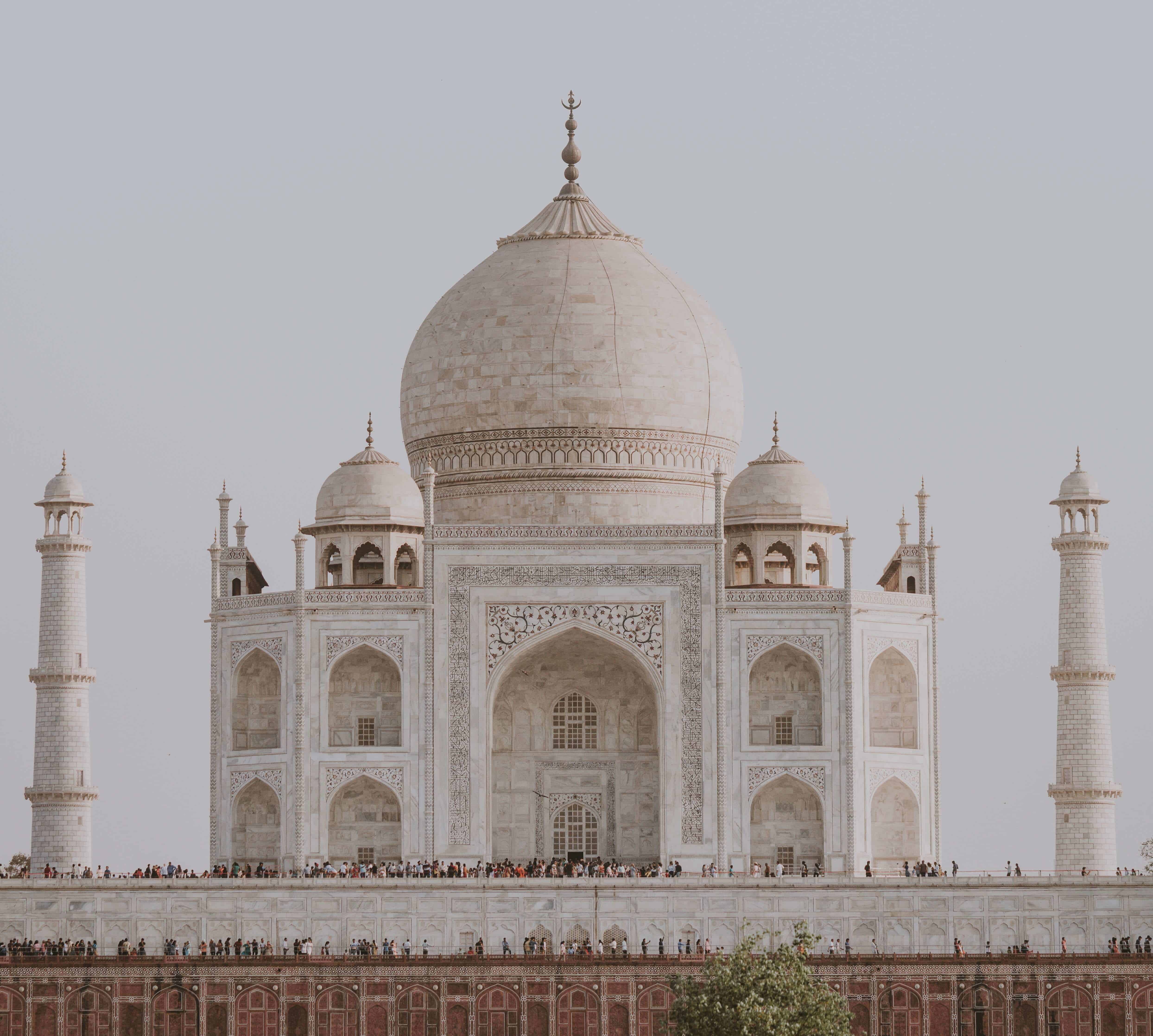
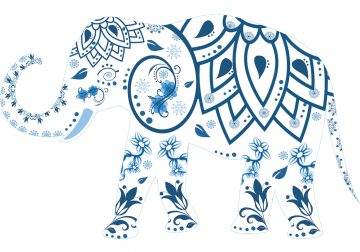

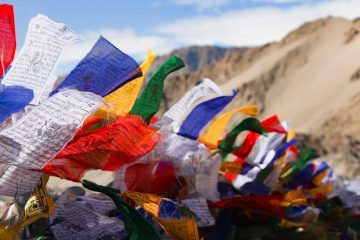
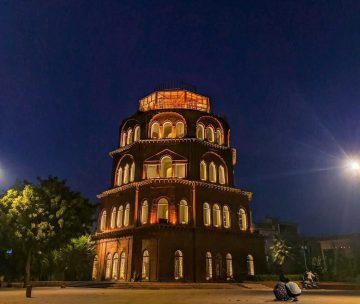
Pingback: Beyond the Taj Mahal: Things to do in Agra - The Budget Your Trip Blog
Pingback: The Sunrise Tour of Taj Mahal - Talk Travel